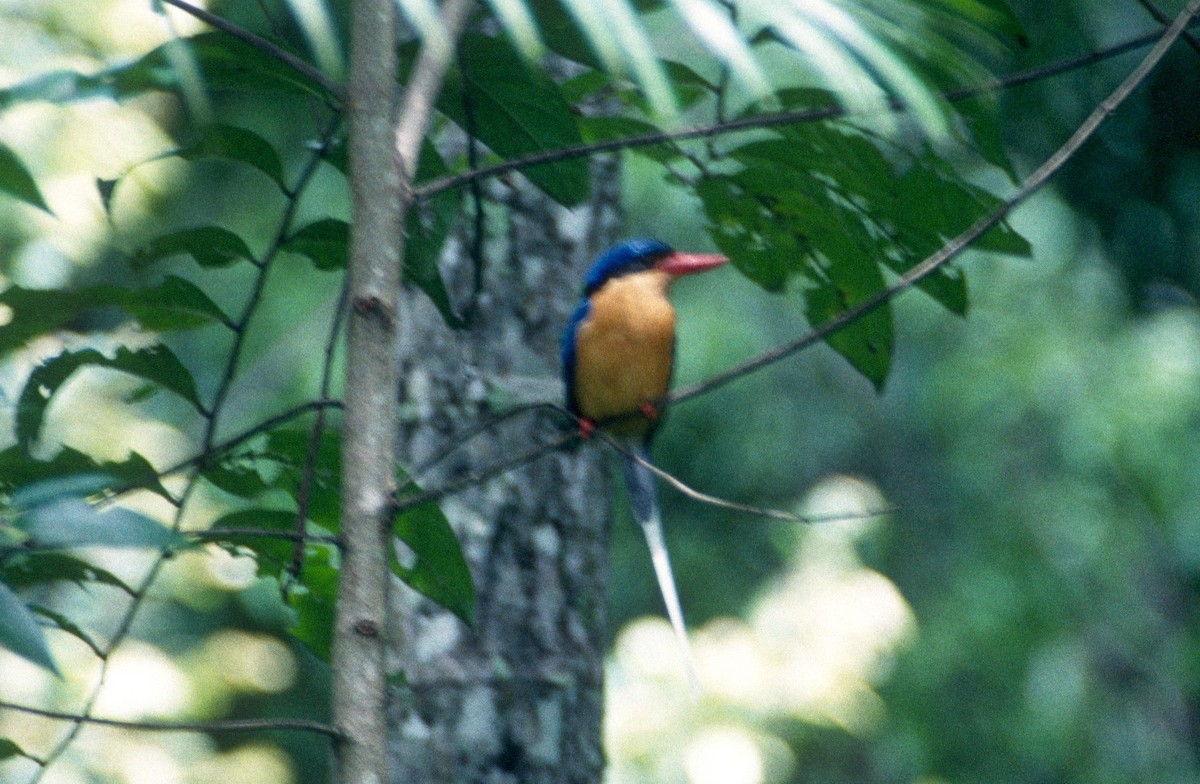Buff-breasted Paradise Kingfisher
A species of Paradise Kingfishers Scientific name : Tanysiptera sylvia Genus : Paradise Kingfishers
Buff-breasted Paradise Kingfisher, A species of Paradise Kingfishers
Botanical name: Tanysiptera sylvia
Genus: Paradise Kingfishers
Content
Description General Info
 Photo By Don Roberson
Photo By Don Roberson Description
Like all paradise kingfishers, the buff-breasted is brightly coloured with a large red bill, rich rufous-buff underparts, blue or purple cap, crown and outer tail feathers, black eye stripes running down to the nape of its neck, red feet, white lower back and rump and long white or blue-and-white tail-feathers which varies geographically. The identifying feature is the white patch on the centre of the upper back. The juvenile has a brown bill, yellowish feet, is duller and lacks long tail feathers. An adult male is 35 cm (14 in) in length including the tail feathers which extend 13 cm (5.1 in) beyond the rest of the tail. An adult female is 30 cm (12 in), including much shorter tail feathers, extending 8 cm (3.1 in) beyond the rest of the tail. Tails vary in length but are approximately 18 cm (7.1 in). Tail-feathers of juveniles and immatures are shorter than adults. The tail feathers are often damaged towards the end of the breeding season, most likely from entering and leaving the burrow and regrow before the next mating season. The wingspan for an adult male is 35 cm (14 in) and adult female is 34 cm (13 in). They weigh 45–50 g (1.6–1.8 oz). 
Size
37 cm
Nest Placement
Tree
Feeding Habits
Buff-breasted Paradise Kingfisher primarily consumes insects, earthworms, spiders, small reptiles, and amphibians. It forages from the forest understory to the canopy, adeptly hunting both on the ground and among foliage. Both parents feed the offspring, indicating a cooperative approach to chick-rearing.
Habitat
The buff-breasted Paradise Kingfisher primarily inhabits monsoon forests, notophyll vine forests, and lowland hill forests with a tall understory and sparse ground cover. These birds are typically associated with regions that feature ample watercourses and may be found in isolated forest patches. They have a specific breeding requirement for termite mounds and are known to occupy higher forest levels in areas where they coexist with closely related species.
Dite type
Insectivorous
General Info
Feeding Habits
Bird food type
Behavior
The species shows signs of territorial behaviour in non-breeding grounds in New Guinea where single birds defend their resources. During the breeding season in Australia territories are defended by pairs. 
Distribution Area
During the breeding season from November to March, the buff-breasted paradise kingfisher is found in coastal north-east Queensland from islands in the Torres Strait and Cape York Peninsula south to Byfield, in central Queensland. Individual sightings have been recorded at Eurimbula National Park, south of Gladstone, and on islands of the Great Barrier Reef. The buff-breasted paradise kingfisher inhabits lowland monsoon rainforest, and isolated patches of hill forest in areas where active termite mounds suitable for nesting are located. They usually perch in the mid-storey and lower canopy, coming to the ground to feed. In some areas they occur alongside the common paradise kingfishers. 
Species Status
Natural predators of nest eggs include snakes and goannas, whilst a butcherbird has also been observed preying on young. Land clearing and habitat loss in New Guinea have the potential to impact on the breeding populations in Australia. Although the population trend is declining, the buff-breasted paradise kingfisher is assessed as least concern on the IUCN Red List. 

 Photo By Don Roberson
Photo By Don Roberson